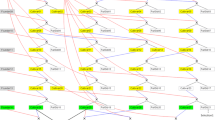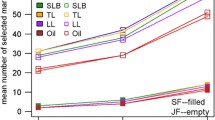Abstract
Two methods, following different statistical paradigms for mapping multiple quantitative trait loci (QTLs), were compared: the first is a frequentist, the second a Bayesian approach. Both methods were applied to previously published experimental data from an outbred progeny of a single cross between two apple cultivars (Malus pumila Mill.). These approaches were compared with respect to (1) the models used, (2) the number of putative QTLs, (3) their estimated map positions and accuracies thereof and (4) the choice of cofactor markers. In general, the strongest evidence for QTLs, provided by both methods, was for the same linkage groups and for similar map positions. However, some differences were found with respect to evidence for QTLs on other linkage groups. The effect of using cofactor markers which were selected differently was also somewhat different.
Similar content being viewed by others
Author information
Authors and Affiliations
Additional information
Received: 17 July 2000 / Accepted: 13 January 2001
Rights and permissions
About this article
Cite this article
Maliepaard, C., Sillanpää, M., van Ooijen, J. et al. Bayesian versus frequentist analysis of multiple quantitative trait loci with an application to an outbred apple cross. Theor Appl Genet 103, 1243–1253 (2001). https://doi.org/10.1007/s001220100720
Issue Date:
DOI: https://doi.org/10.1007/s001220100720




